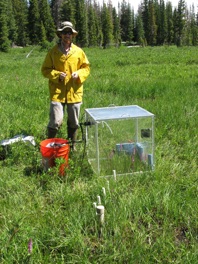Rocky Mountain fens are supported by ground water discharge from hillslope talus, alluvial fans and glacial moraines and deeper ground water flow systems. These aquifers have very small capacity and typically are recharged by snowmelt in the spring, but begin to run out of water by early July. Many fen aquifers are recharged by monsoon precipitation in late summer. Fens also have formed as higher as upper treeline, and as low as foothills or basins adjacent to mountain fronts. The climates that fens have formed in is highly variable and the effect of climate change on high vs. low elevation fens, and those that are supported solely by snowmelt compared with those that also receive summer precipitation, is likely to be complex. This research program, in cooperation with and sponsored by the US Forest Service Rocky Mountain Research Station, is addressing the hydrologic characteristics and carbon storage of fens along these complex elevation and climate gradients within the Rocky Mountains of Colorado and Wyoming. This research program is being conducted by Ph.D. graduate student David Millar (bottom right photo). Our Forest Service collaborators are Dr. Kathleen Dwire and Dr. Robert Hubbard. One of the research study sites, Anglica fen is shown above.

